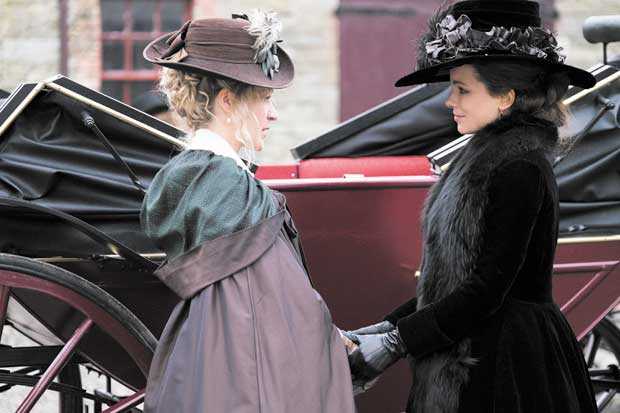Why it took 25 years for Whit Stillman to become an overnight sensation
ARNOLD WAYNE JONES | Executive Editor
 At age 64, Whit Stillman is aware that his days as a wunderkind of indie cinema are behind him. And frankly, he’d appreciate a little mainstream success.
At age 64, Whit Stillman is aware that his days as a wunderkind of indie cinema are behind him. And frankly, he’d appreciate a little mainstream success.His new film, Love & Friendship, goes wide this weekend, showing eventually on more than 900 screens; that’s a far cry from the 63 prints of his debut film, 1990’s Metropolitan, which he roadshow’ed around the art houses of North America on its way to an impressive $3 million gross. (“And that was on old ticket prices,” he insists.) Does this feel like a change? I ask.
“I certainly hope so! I could use one,” he excitedly offers.
Success for Stillman, however, looks like it will come not by directing the latest comic book movie, but in putting one of Jane Austen’s few unadapted stories in the cinemas: Love & Friendship is based upon Austen’s epistolary novella Lady Susan, above a conniving widow who puts her own comfort about her daughter and those in her charismatic orbit. Leave it to Stillman to “go big” with an 18th century comedy of manners.
It’s just one of the quirks that has made the writer-director — who has made only four other feature films in more than 25 years — such a compelling figure in filmdom. His writing is smart, precise and whimsical, his visual style languid but deceptively simple. He’s like a Wes Anderson without all the matte shots and bravado.

‘Last Days of Disco’ co-stars Chloe Sevigny and Kate Beckinsale reunite for a very different period piece, the Jane Austen comedy of manners ‘Love and Friendship,’ also directed by White Stillman.
And this time around, he’s also like Stanley Kubrick. For real.
I tell Stillman that Love & Friendship triggered in me a recognition that his style is similar to Kubrick: They both make comedies with an underlying sense of awfulness. And L&F in particular echoed Kubrick’s Barry Lyndon, based on the Thackeray novel. Stillman nods.
“It was hard to avoid it — just was one of the problems we faced,” he acknowledges. “We were very aware at every phase that we didn’t want to hit the third rail [of seeming too similar]. There were a few Kubrickian touches: It’s a period film, a very literary adaptation; we were shot in Anglo-Ireland, [Lyndon] was about Anglo-Ireland; and we both love baroque music so there was that. Kubrick used Handel’s ‘Sarabande’ and we used that [on the rough cut] until we found Purcell’s ‘Funeral March for Queen Mary.’”
It may seen odd that Stillman would fret about recalling a 40-year-old art film that — more than likely — most moviegoers wouldn’t know anything about. But that’s not how he sees it.
“All the people who will be commenting on our film will have their claws sharpened,” he says. (We talked before the reviews started pouring in; so far, the majority have been ecstatic raves.)
It’s not surprising that Stillman would be so sensitive to the vagaries of public opinion. When you work for half your life in the indie film world, successes are measures in teaspoons, not oceans. Stillman seemed relieved t0 learn that I enjoyed his last film, Damsels in Distress, which, he claims, got savaged by segments of the film critic community.
But as much as he craves mainstream acclaim (despite an Oscar nomination for Metropolitan, and art-house hits with Barcelona and Last Days of Disco), Whit Stillman remains, unrepentantly, Whit Stillman. He writes with more intelligence than you expect from a run-of-the-mill summer-movie fan. He makes casual references in conversation to Henry James and admits he doesn’t know what “heavy metal music” is.
And he returns to working with actors with whom he develops a rapport and who fit well in his aesthetic, including a here reunion with Kate Beckinsale and Chloe Sevigny, who play the anti-hero and her best friend in Love & Friendship.
“I initially wrote [the role in Disco] for Kate because I liked her in Cold Comfort Farm, and then I thought of her right away for this,” he says. “On set, there’s no real direction going on [with the actors] — in the auditions you see the actor doing all the right stuff [with the script],” and turn her lose, he says. And he casts equally imposing figures like Stephen Fry, who has a supporting role here, not for box-office draw but for the glory of working with them. (“Stephen Fry is the most impressive person I’ve ever met — totally intimidating. Enormously tall and funny,” he says.)
Stillman’s prickliness may be what has kept him from churning out a new film annually like Woody Allen does; he’s lived much of the last two decades in Paris, and he’s quick to mock moviemaking trends he disagrees with. (Long, single tracking shots? Hates them… though he admits it was well-used in Goodfellas. The minimalist Dogma 95 aesthetic developed by some European filmmakers? “So stupid … but what a good gambit it was. I would love to do some idiotic manifesto filled with pretension, but I couldn’t keep a straight face pitching it.”) No, if Whit Stillman is going to be an overnight sensation, it will be on his terms … even if it takes 25 years to achieve it.
This article appeared in the Dallas Voice print edition May 20, 2016.

















